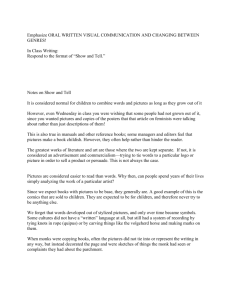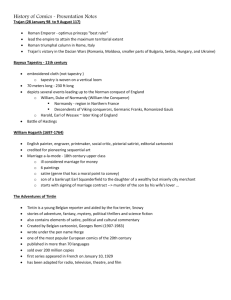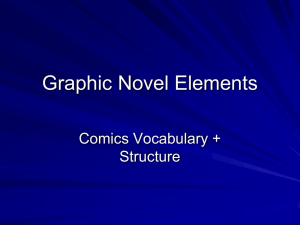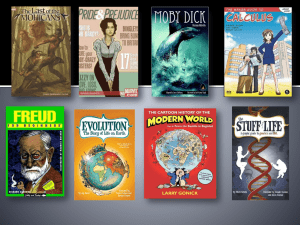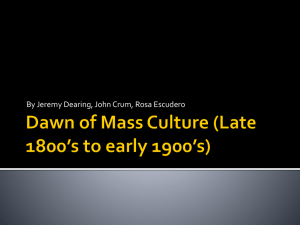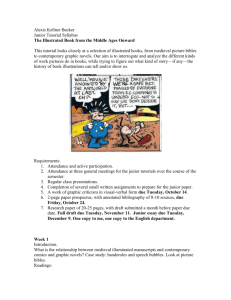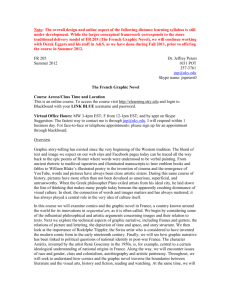Fall 2008
advertisement
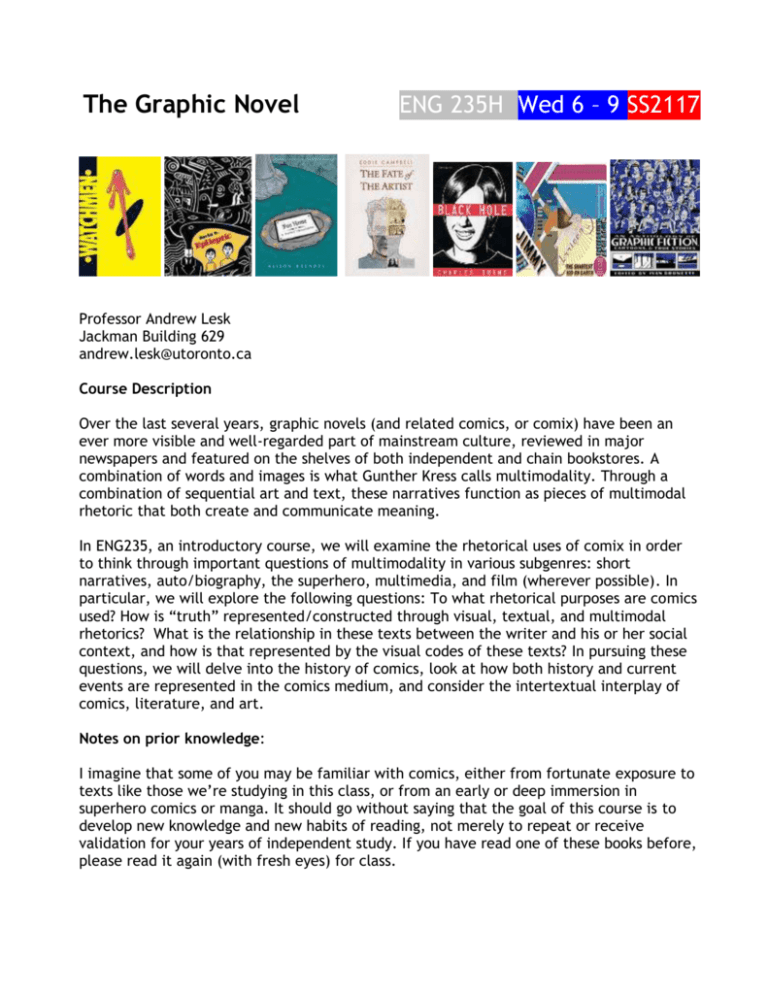
The Graphic Novel ENG 235H Wed 6 – 9 SS2117 Professor Andrew Lesk Jackman Building 629 andrew.lesk@utoronto.ca Course Description Over the last several years, graphic novels (and related comics, or comix) have been an ever more visible and well-regarded part of mainstream culture, reviewed in major newspapers and featured on the shelves of both independent and chain bookstores. A combination of words and images is what Gunther Kress calls multimodality. Through a combination of sequential art and text, these narratives function as pieces of multimodal rhetoric that both create and communicate meaning. In ENG235, an introductory course, we will examine the rhetorical uses of comix in order to think through important questions of multimodality in various subgenres: short narratives, auto/biography, the superhero, multimedia, and film (wherever possible). In particular, we will explore the following questions: To what rhetorical purposes are comics used? How is “truth” represented/constructed through visual, textual, and multimodal rhetorics? What is the relationship in these texts between the writer and his or her social context, and how is that represented by the visual codes of these texts? In pursuing these questions, we will delve into the history of comics, look at how both history and current events are represented in the comics medium, and consider the intertextual interplay of comics, literature, and art. Notes on prior knowledge: I imagine that some of you may be familiar with comics, either from fortunate exposure to texts like those we’re studying in this class, or from an early or deep immersion in superhero comics or manga. It should go without saying that the goal of this course is to develop new knowledge and new habits of reading, not merely to repeat or receive validation for your years of independent study. If you have read one of these books before, please read it again (with fresh eyes) for class. II Important: do not assume that a long acquaintance with genre comics will give you an advantage over your classmates, or will make this course “easy” for you. Much of what we read will stretch your standards and your comfort zone; these literary comics will often have merit precisely insofar as they present an unfamiliar terrain. Plan to be surprised. REQUIRED TEXTS Moore, Alan B, David Bedchel, Alison Campbell, Eddie Burns, Charles Ware, Chris Watchmen (1986/87) Epileptic (1996 – 2003) Fun Home (2006) Fate of the Artist (2006) Black Hole (1995 – 2005) Jimmy Corrigan (2000) Brunetti, Ivan, ed. An Anthology of Graphic Fiction, Cartoons, and True Stories (2006) (selections listed below) All books have been ordered from The Labyrinth. For location and address, see http://www.thelabyrinthstore.com. A note about book costs: I realize that graphic novels are more costly than regular English lit texts; there is little that one can do about this. I am teaching the course again in the Winter, so you may otherwise wish to buy/sell your books via http://tusbe.com. The Beguiling, on Markham St, often sells their books at USmarked prices. Some of the books are also available at the UofT Bookstore. Marking Scheme Shorter Test Essay Final Test 20% 50% 30% Tests and Essays Test formats will be announced in class; they will not be posted on Blackboard. The Essay will be posted on Blackboard. Office Hours / Email / Blackboard / Technology I am always happy to meet with students (at my office or a suitable public place nearby) or answer questions via email. You can expect to receive a response to email messages within 24 hours (except on weekends). I will not answer emails for which the answer might be found by having attended the class, and/or by referring to Blackboard. Questions that apply to class lectures should be asked in class, since it is most often the case that if you are thinking it, someone else is as well. Class material (such as lectures, or notes on an upcoming test) will not be posted on Blackboard. If it is not on Blackboard, and if I do not state in class that I will post it on Blackboard, then rest assured it will not be posted. III Technology in the classroom: as all classes are now hotwired, the use of appropriate technology is an issue. Anything that does not relate to what is going on in the class and/or has the potential to disrupt the class should not be used/accessed (eg the Internet; text messaging). Laptops should be used only for taking notes, and cell phones must be turned off and put away. Grading I adhere to the guidelines outlined by the department. Refer to http://www.utoronto.ca/writing/grading.html. There is also an assessment rubric on Blackboard. Getting Essay Help, and Accessibility Services Please consult http://www.utoronto.ca/ucwriting/index.html . Every college has a free writing lab; these labs are excellent resources. Regarding AS: Please see the AS office in the Robarts library if you have certain accessibility needs. I fully support the aims and goals of AS. Week 1: Sep 10: Overview Historical and thematic overview of the course. Initial discussion: Reasons, interests, favorites. Modern comics: Topffer, Wilhelm Busch and numerous German artists. Examples of 19th century work. The newspaper comics era; comics as a commercial medium; Krazy Kat, Little Nemo in Slumberland, Nancy. Delineation between the comic strip and later comic book: Peanuts and Pogo, Superman and Batman. Bande desinée. Comic book explosion in the early 1940s, experiments in the underground: Carl Barks, John Stanley, Harvey Kurtzman, and EC Comics, Frederic Wertham. 1960s and '70s: superhero/genre based artist: Doug Wright, Charles Schultz, Jack Kirby, Steve Ditko, Harry Lucey, and Ogden Whitney and their contemporaries. The Chicago Imagists vs. New York Pop Art. The (Long) Rise of the Graphic Novel: The graphic novel in fact begins in the 1920s. A look at serious long-form picture narratives from Frans Masereel to Lynd Ward to Chris Ware. Comic criticism (from Scott McCloud). Week 2: Sep 17 & Background readings to do on your own: see handout on Blackboard IV Week 3: Sep 24 & selections moved to Oct 15 Week 4: Oct 1; Week 5: Oct 8 One hour 15 min test Oct 11t& Oct 1 (2nd half of class) & Oct 8 Week 6: Oct 15 & Aesthetic Considerations Newgarden “Love’s Savage Fury” (14-17) Mazzuchelli “The Boy Who Loved Comics” (30-31) Tomine from Hawaiian Getaway (176-183) Hernandez “Flies on the Ceiling” (190-204) McGuire “Here” 88-93 Read on your own… Beyer from Agony (68-72) Regé from Boys (52-56) Moriarty from Jack Survives (138–140) Crumb “Jelly Roll Morton’s Voodoo Curse” (311-316) V Week 7: Oct 22 & Gloeckner “Fun Things…” (215-17) Dreshler “Visitors in the Night” (218-23) Bell “Cecil and Jordan in New York” 279-82 Tyler “Gone” 293-98 Read on your own… Lynda Barry (various, 46-51) Kominsky-Crumb “Of What Use is a Bunch?” (65-67) Julie Doucet from My New York Diary (256-63) Week 8: Oct 29 & Schulz “Developing a Comic Strip” 37-39 (1959) Spiegelman “Abstract Thought is a Warm Puppy” 32-34 (14.2.00) Ware “Charlie Brown, Snoopy, Linus, Lucy…” 35 (2000) Seth “Good Grief!” 36 (1993) Sikoryak “Good Ol’ Gregor Brown” 40-41 (1990) Seth from It’s a Good Life If You Don’t Weaken 242-55 Collier “The Ethel Catherwood Story” 337-50 Read on your own… Crumb “Uncle Bob’s Mid-Life Crisis” 303-310 Brown from Binky Brown... 205-14 Week 9: Nov 5 & VI Week 10: Nov 12 Week 11: Nov 19 Essay due t Week 12: Nov 26 & Week 13: Dec 3 Two hour test t Kaz “Underworld” (18-23) Millionaire “Maakies’ (24-26) Griffith “Zippy” (29) Brinkman “Oaf” (73-76) Woodring “Frank’s Fish” (77-79) Prewitt “Sof’ Boy” (100-03) Read on your own… Heatley “Northern California” 276-78 VII Read Clowes “Gynecology” (375-96) in preparation for the Test
